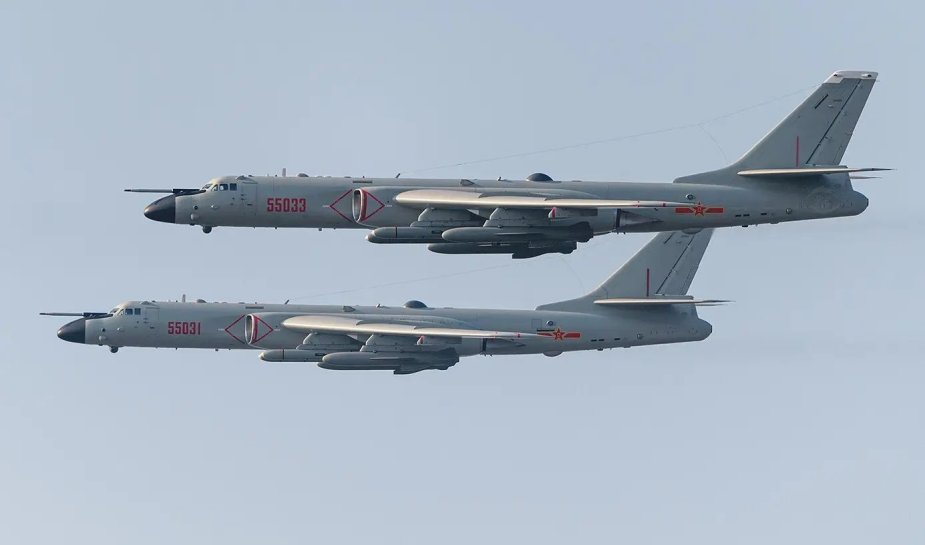Breaking news
China's Aggressive Military Maneuvers: Chinese warplanes flying over Taiwan.
According to Taiwan's defense ministry, China deployed navy ships and a significant number of warplanes, including J-10, J-16 fighter jets and H-6 bombers, toward Taiwan on Tuesday, July 11th, and Wednesday, July 12th., 2023. This military movement occurred just ahead of Taiwan's annual military exercises, which aim to enhance its defensive capabilities against potential invasion threats.
Follow Air Recognition on Google News at this link
 Chinese H-6 Bombers have flown over Taiwan territory. (Picture source: 兵事网-美媒 )
Chinese H-6 Bombers have flown over Taiwan territory. (Picture source: 兵事网-美媒 )
In recent months, China has intensified its military intimidation tactics towards Taiwan, leading to heightened tensions in the region and global concerns, as reported by the Army Recognition editorial team on June 2, 2023. The Chinese People's Liberation Army Air Force (PLAAF) has frequently conducted air intrusions into Taiwan's air defense identification zone, often crossing the unofficial boundary of the Taiwan Strait. These incursions have necessitated Taiwan to respond by scrambling its own fighter jets.
During the recent military maneuvers from 6 a.m. on Tuesday, July 11th, 2023, to 6 a.m. on Wednesday, July 12th, China's People's Liberation Army deployed a total of 38 warplanes and 9 navy vessels near Taiwan. Additionally, from Wednesday morning until noon, another 30 planes, including J-10 and J-16 fighters, were flown. Notably, H-6 bombers executed a significant maneuver, flying in a large loop to the south of Taiwan, passing the island before returning towards China's southern coast.
Out of the deployed aircraft, 32 crossed the unofficial boundary known as the midline of the Taiwan Strait, which traditionally acted as a buffer between the island and the mainland. On Wednesday, July 12th, a further 23 planes breached the midline, further escalating tensions in the region.
China utilized a variety of advanced fighter jets during these air intrusions, including the J-10 and J-16 fighters. The J-10, also known as the "Vigorous Dragon," is a single-engine multirole fighter equipped with advanced avionics and medium-range air-to-air missiles. It possesses high maneuverability and the capability to engage multiple targets simultaneously.
On the other hand, the J-16 is a dual-seat, multi-role strike fighter designed for both air-to-air and air-to-ground missions. It is equipped with advanced radar systems, long-range air-to-air missiles, and precision-guided munitions. The J-16's range and payload capacity make it a formidable asset for offensive operations.
The H-6 is a versatile Chinese strategic bomber derived from the Soviet Tu-16 bomber, often compared to the American B-52 Stratofortress in terms of its role and size. The H-6 features a robust design and a large payload capacity.
Capable of conducting long-range conventional or nuclear bombing missions, the H-6 can carry various payloads, including cruise missiles, dropped bombs, torpedoes, and mines. With air-to-ground, air-to-sea, and air-to-air capabilities, it demonstrates versatility in fulfilling different mission requirements.
Equipped with turbojet engines, the H-6 attains high cruising speed and long endurance. It is also fitted with advanced navigation, communication, and targeting systems, enabling effective operations in diverse environments and precise strikes on targets.
From a general perspective, China has engaged in information warfare alongside its military actions, employing disinformation campaigns, cyberattacks, and psychological operations to influence public opinion, undermine Taiwan's government, and gain access to sensitive information. Furthermore, China continues to exert diplomatic pressure on Taiwan, seeking to isolate it internationally by limiting its participation in global forums and pressuring countries to sever ties with Taipei. These combined efforts aim to reinforce China's claim of sovereignty over Taiwan and diminish Taiwan's standing on the global stage.



















